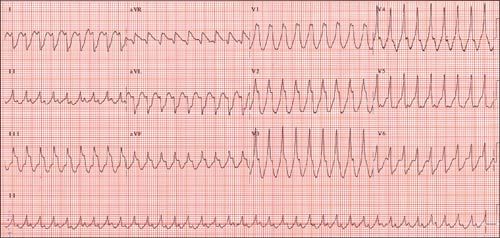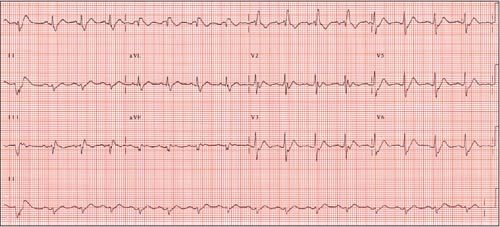- Clinical Technology
- Adult Immunization
- Hepatology
- Pediatric Immunization
- Screening
- Psychiatry
- Allergy
- Women's Health
- Cardiology
- Pediatrics
- Dermatology
- Endocrinology
- Pain Management
- Gastroenterology
- Infectious Disease
- Obesity Medicine
- Rheumatology
- Nephrology
- Neurology
- Pulmonology
A Retrospective Diagnosis of Ventricular Tachycardia
Ventricular versus supraventricular tachycardia? This case offers diagnostic and treatment strategies when the diagnosis is uncertain.
A 63-year-old man complained of sudden dizziness and dyspnea while sitting at his desk at work. His coworker called an ambulance. On presentation to the emergency department, the patient was pale and diaphoretic; heart rate was 240 beats per minute and blood pressure was 100/70 mm Hg. He denied chest pain, nausea, vomiting, and substance abuse. A 12-lead ECG revealed a broad complex tachycardia with a heart rate of 216 beats per minute (Figure 1). He underwent electrical cardioversion and was admitted for further evaluation and treatment.
The postcardioversion ECG revealed a heart rate of about 90 beats per minute with right bundle-branch block (BBB) (Figure 2). Because the patient was safely in sinus rhythm, all previous ECGs were reviewed. A wide QRS complex with a right BBB was noted in the baseline ECG (seeFigure 1). Although there was a concern for supraventricular tachycardia with aberrancy, close review of the ECGs led to the diagnosis of ventricular tachycardia in retrospect.

Click to Enlarge
Figure 1 – Review of The baseline ECG after cardioversion revealed a wide QRS complex with a right bundlebranch block. This finding led to the diagnosis of ventricular tachycardia in retrospect.

Click to Enlarge
Figure 2 – The postcardioversion ECG showed normal sinus rhythm with right bundle-branch block.
SUPRAVENTRICULAR TACHYCARDIA VERSUS VENTRICULAR TACHYCARDIA
The presence of a monophasic R wave (without rSR′) or a biphasic QRS complex in lead V1 favors the diagnosis of ventricular tachycardia. A triphasic QRS complex in V1 favors ventricular tachycardia when it is an RSr′; however, this is more likely supraventricular tachycardia with aberrancy when it is the classic right bundle pattern of rSR′. This rSR′ complex in lead V1 does not exclude ventricular tachycardia. An R/S ratio of less than 1 in V6 in such cases favors the diagnosis of ventricular tachycardia over supraventricular tachycardia with aberrancy, as does precordial concordance (the major vector of the QRS complex across the precordium is either positive or negative but does not transition).1,2
How the diagnosis was made. In this case, there was no definite rSR′ in lead V1, the ratio of R/S in V6 was close to 1, and the QRS complex showed positive concordance; thus, ventricular tachycardia was the favored diagnosis.2,3 After evaluation of the baseline ECG, the patient was referred for further electrophysiological studies that confirmed the diagnosis of ventricular tachycardia.
How to approach uncertain cases. Atrioventricular dissociation and the presence of capture or fusion beats are essentially diagnostic of ventricular tachycardia and almost all patients with a history of myocardial infarction have ventricular tachycardia, not supraventricular tachycardia.4 When in doubt, treat for ventricular tachycardia. Assuming ventricular tachycardia until proved otherwise even in the hemodynamically stable patient is the safest approach to management. Treating supraventricular tachycardia with aberrancy as though it were ventricular tachycardia is not dangerous; however, treating ventricular tachycardia as though it were supraventricular tachycardia with aberrancy can make a bad situation worse.1,3
Amiodarone is a safe choice when the diagnosis is unclear.3,5 If ventricular tachycardia is mistaken for supraventricular tachycardia with underlying BBB and treated with intravenous atrioventricular nodal blockade (eg, with verapamil or diltiazem), death may result.1 Fortunately, cardioversion is effective in restoring almost all wide complex QRS tachycardias to sinus rhythm, including ventricular tachycardia and supraventricular tachycardia.3
KEY POINTS FOR YOUR PRACTICE
In the stable patient, when the diagnosis is uncertain, it is essential to obtain a 12-lead ECG to assess for ventricular tachycardia versus supraventricular tachycardia with aberrancy and then to compare it with a baseline ECG. In unstable patients, it is helpful to obtain the 12-lead tracing for diagnostic purposes while preparing the patient for electrical therapy; however, treatment priorities and the patient’s safety take precedence.
References:
REFERENCES:1. Nabar A, Nathani PJ. Ventricular tachycardia: tricks and traps. J Assoc Physicians India. 2007;55 (suppl):39-42.
2. Brugada P, Brugada J, Mont L, et al. A new approach to the differential diagnosis of a regular tachycardia with a wide QRS complex. Circulation. 1991;83:1649-1659.
3. Wellens HJ, Bar FW, Vanagt EJ, et al. The differentiation between ventricular tachycardia and supraventricular tachycardia with aberrant conduction: the value of the 12-lead electrocardiogram. In: Wellens HJ, Kulbertus HE, eds. What’s New in Electrocardiography? The Hague, the Netherlands: Martinus Nijhoff Publishing; 1981:184-199.
4. Ricou F, Nicod P, Gilpin E, et al. Influence of right bundle branch block on short- and long-term survival after acute anterior myocardial infarction. J Am Coll Cardiol. 1991;17:858-863.
5. Lam P, Saba S. Approach to the evaluation and management of wide complex tachycardias. Indian Pacing Electrophysiol J. 2002;2:120-126.
